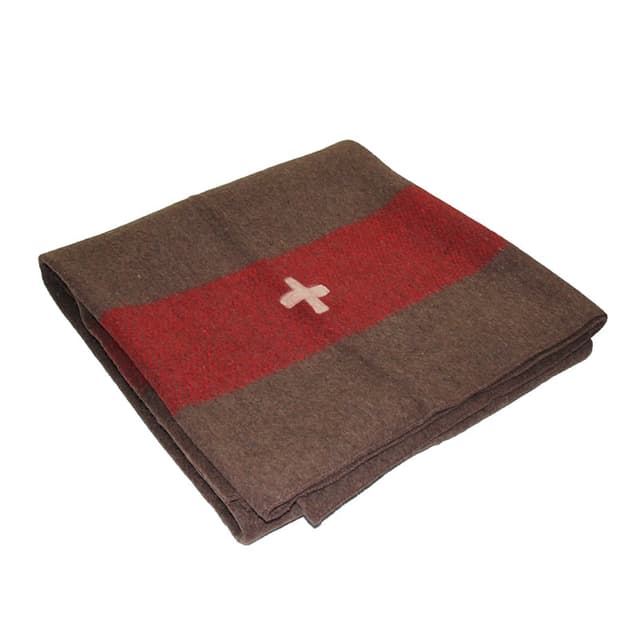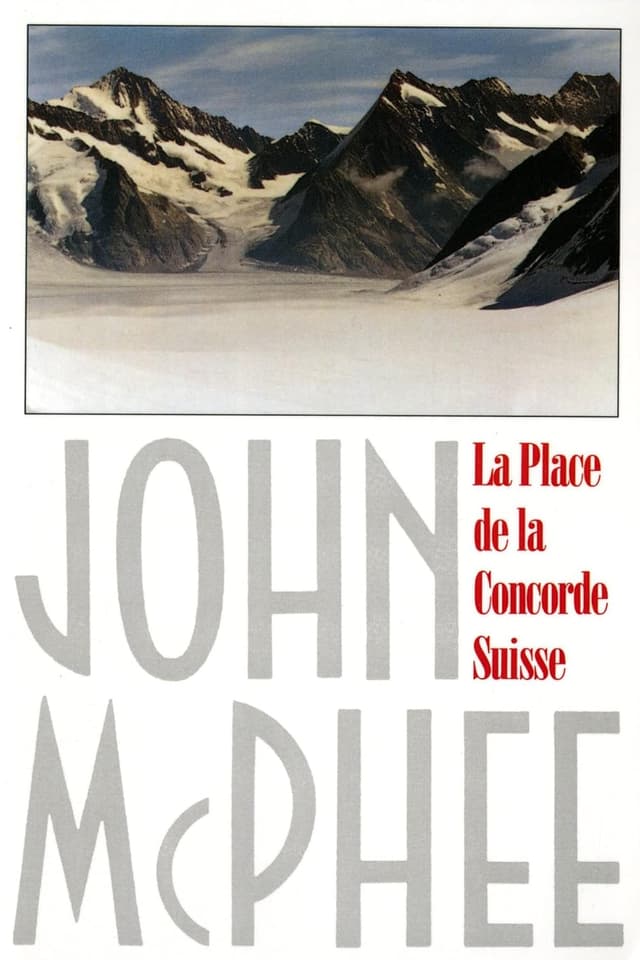Jann Schwarz | February 23, 2021
The Swiss Army Edition
On blankets, protection, and geography
Recommended Products

A nicely illustrated book on Alpine Cooking, offering an escapist reverie of the Swiss Alps and its culinary delights.

A Swiss Army blanket made of thick felted wool, brown with a red stripe and a Swiss white cross, known for its unique texture and slightly musty but not unpleasant odor.

A rich, journalistic study of the Swiss Army's role in Swiss society by Pulitzer-Prize-winning author John McPhee, written in the early 1980s.

Swiss-made new versions of the Swiss Army blanket, known for its ultra-rugged pure wool, ultra-utilitarian modernist design, and warmth. Unlike vintage versions, these lack the authentic musty musk.
Jann Schwarz (JS) is a WITI contributor and bon vivant from the Engadin valley. He wrote an exceptional piece on bandanas, which if you are a new subscriber you should be sure to read pronto. -Colin (CJN)
Jann here. The Swiss Army is world-famous. Not so much for its fighting skill, but for the very high-quality standards of its procurement officers. Not unlike the Japanese, well-made things are an obsession for the Swiss. The legendary pocket knife given to Swiss Army officers (and NASA astronauts) has turned its manufacturer Victorinox into a global luggage-licensing juggernaut. But what about the other gear? Much of it was designed so well in order to function in a harsh Alpine winter environment.
Maybe it was the dysfunction of power grids and the hidden fragility of busted water heaters laid bare by the recent polar vortex calamity in the US that made me think of this. Or maybe, stuck inside my Brooklyn apartment on snowy days, I just long for the virgin powder and majestic vistas of the Swiss Alps, where I grew up. Browsing through a nicely illustrated book on Alpine Cooking (a recent gift from friends) has sent me off into escapist reveries during endless Zoom calls.
I have been daydreaming about sunny winter afternoons under cloudless skies spent on the terraces of ski hut-type restaurants in the Engadin Valley: enjoying the view and indulging in the hearty cuisine of Engadiner Gerstensuppe (barley soup), bratwurst, venison stew, and Apfelstrudel.
I miss favorite haunts like Mouttas Muragl, Val Roseg, or the swanky El Paradiso.
Why is this interesting?
And what does it have to do with Swiss Army gear? Well, I remembered that growing up, one of the quirks of these Alpine outdoor dining experiences was that they would provide you with sheepskin rugs to sit on, and old surplus Swiss Army blankets to fend off the cold (see image below).
Unable to get to the mountains, I figured the mountains could move to me if I tracked down a Swiss Army blanket. With it, I could sit on the patio furniture of my rooftop in the snow, heated by fragrant pinon wood burning in my Solo stove. Sipping gluhwein I would pretend that the Williamsburg waterfront condo buildings were Alpine peaks. Call it pandemic LARPing.
It is the unique texture and smell of these blankets that has stuck in my mind. They are brown with a red stripe and a Swiss white cross and are made of thick felted wool. And they always seem to have the slightly musty but not unpleasant odor of something that has been stored in a basement or a horse stable for a long time.
As it turns out, that smell is a tell-tale sign of their collective origin story. These blankets are a relic from a time when the army played an outsized role in the Swiss collective imagination. Unlike all of its neighbors, Switzerland survived World War II fairly unscathed. Local public opinion at the time attributed this to the Swiss Army’s immediate mobilization against possible invasion by Nazi Germany based on a strategy called The National Redoubt. This envisioned a defensive retreat into an impregnable complex of mountain fortifications that would deny an aggressor the essential passage over the Alps by controlling the major mountain passes and railway tunnels.
Historians may disagree over how accurate this point of view really is, and how many financial dealings and other backroom maneuvers kept the country out of the war. Nevertheless, the Swiss military developed an obsession with holding and defending the Alps that outlasted the Cold War and bordered on paranoia about a Soviet invasion or a nuclear attack. This involved massive infrastructure like bunkers for the entire population, with bizarre details like anti-tank gun turrets disguised as quaint chalets and fighter plane hangars hidden inside mountains. The Swiss had an enormous standing militia-system army, and more small guns owned per capita than any other country except Yemen and the United States. Until 1973, horse-mounted Swiss dragoons were the last non-ceremonial horse cavalry in Europe, as were Swiss bicycle infantry battalions, until 2001. For a small country of fewer than 8 million people, 750,000 troops were maintained until 1995, when a gradual ramp-down to a more reasonable 80,000 troops by 2020 began.
Such collective martial mentality required large supplies of everything, including hundreds of thousands of blankets stored in hundreds of army depots and bunkers. At the turn of the Millennium, over 300,000 blankets were still in use, and with the downsizing of the army, many ended up being sold as surplus, which is when the ski restaurants must have picked them up.
They are remarkable examples of craftsmanship because they are designed for decades of continuous use and made in Switzerland, woven of ultra-rugged pure wool. Until the 1970s they were hand-finished, with the year of production painstakingly felted into the wool, along with the obligatory Swiss white cross.
Their ultra-utilitarian, modernist design and the fact that they are extremely warm and indestructible make them perfectly suited for hipster survivalists and Park Slope glampers, a suddenly underserved market following Best Made Co’s ill-timed demise.
There is a brisk trade on Etsy, but If you think of getting one, beware of cheap imitations made elsewhere. And be mindful that the vintage originals differ in key details from the more recent Swiss-made new versions that are available at the excellent Manufactum website: a lack of the hand-finish and most crucially, the absence of the authentic musty musk that can only be achieved by spending a half-century in a bunker.
PS: To complete the full look, there is also an original Swiss Army bicycle which is available to civilians and guaranteed to turn heads among the Brooklyn-based creative classes, and Monocle Magazine subscribers worldwide.
PPS: For a deep dive into this quietly fascinating topic, read La Place de la Concorde Suisse, Pulitzer-Prize-winning non-fiction legend John McPhee's rich, journalistic study of the Swiss Army's role in Swiss society, written in the early 1980s. (JS)
__
Partner Post: WITI x The Browser
With the flood of newsletters, there’s a lot of similar looking links floating around. Enter The Browser. It is a beautiful synthesis of articles you won’t find elsewhere, which opens your brain and your references. Like what we aim to do with WITI, the Browser team are obsessed with quality first and the finest rather than the latest. So there’s no peg to trending topics, but rather high signal, good links. We highly recommend subscribing. Sign up with 20 percent off with a special WITI code by clicking here and using WITI20 at checkout. (CJN)
___
Quick Links:
Official stream of the Perseverance lander (CJN)
Ella drops a knit collection (CJN)
Bill Gates: my green manifesto (CJN)
Thanks for reading,
Noah (NRB) & Colin (CJN) & Jann (JS)
—
Why is this interesting? is a daily email from Noah Brier & Colin Nagy (and friends!) about interesting things. If you’ve enjoyed this edition, please consider forwarding it to a friend. If you’re reading it for the first time, consider subscribing (it’s free!).



